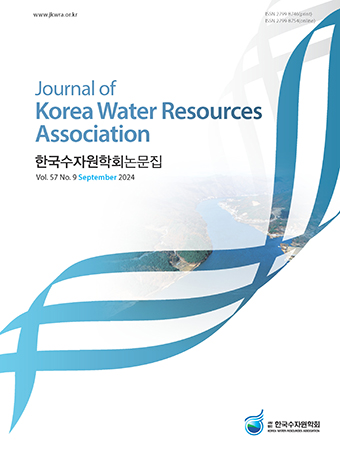Research Article
Blaikie, P., Cannon, T., Davis, I., and Wisner, B. (1994). At risk: Natural hazards, people's vulnerability and disasters. Routledge, London, UK.
Bruneau, M., Chang, S.E., Eguchi, R.T., Lee, G.C., O'Rourke, T.D., Reinhorn, A.M., Shinozuka, M., Tierney, K., Wallace, W.A., and Winterfeldt, D.V. (2003). "A framework to quantitatively assess and enhance the seismic resilience of communities." Earthquake Spectra, Vol. 19, No. 4, pp. 733-752.
10.1193/1.1623497Buckle, P., Marsh, G., and Smale, S. (2001). Assessment of personal and community resilience and vulnerability. EMA Project No. 15/2000, Emergency Management Australia, Canberra, Australia.
Bulti, D.T., Girma, B., and Megento, T.L. (2019). "Community flood resilience assessment frameworks: A review." SN Applied Sciences, Vol.1, No.1663, pp. 1-17.
10.1007/s42452-019-1731-6Burton, C.G. (2012). The development of metrics for community resilience to natural disasters. ProQuest, Ann Arbor, MI, U.S.
Campanella, T.J. (2006). "Urban resilience and the recovery of New Orleans." Journal of the American Planning Association, Vol. 72, No. 2, pp. 141-146.
10.1080/01944360608976734Cutter, S., Barnes, M., Berry, C., Burton, E., Evans, E., Tate, E., and Webb, J. (2008). "Community and regional resilience: Perspectives from hazards, disasters, and emergency management." Geography, Vol. 1, No. 7, pp. 2301-2306.
Cutter, S.L., Burton, C.G., and Emrich, C.T. (2010). "Disaster resilience indicators for benchmarking baseline conditions." Journal of Homeland Security and Emergency Management, Vol. 7, No. 1, 51.
10.2202/1547-7355.1732Edgemon, L., Freeman, C., Burdi, C., Hutchison, J., Marsh, K., and Pfeiffer, K. (2022). Community resilience challenges index. Federal Emergency Management Agency, Washington D.C, U.S.
Godschalk, D.R. (2003). "Urban hazard mitigation: Creating resilient cities." Natural Hazards Review, Vol. 4, No. 3, pp. 136-143.
10.1061/(ASCE)1527-6988(2003)4:3(136)Ha, J., and Chung, G. (2019). "Snow vulnerability analysis for administrative districts in South Korea." Journal of the Korean Society of Hazard Mitigation, Vol. 19, No. 6, pp. 187-195.
10.9798/KOSHAM.2019.19.6.187Hamilton, W.A.H. (2009). "Resilience and the city: The water sector." Proceedings of the Institution of Civil Engineers-Urban Design and Planning, Vol. 162, No. 3, pp. 109-121.
10.1680/udap.2009.162.3.109Hashimoto, T., Stedinger, J., and Loucks, D. (1982). "Reliability, resiliency, and vulnerability criteria for water resource system performance evaluation." Water Resources Research, Vol. 18, No. 1, pp. 14-20.
10.1029/WR018i001p00014Henstra, D. (2012). "Toward the climate-resilient city: Extreme weather and urban climate adaptation policies in two Canadian provinces." Journal of Comparative Policy Analysis: Research and Practice, Vol. 14, No. 2, pp. 175-194.
10.1080/13876988.2012.665215Heo, A. (2016). Disaster resilience in local government: Indicator design and influence factors. Ph.D. Dissertation. Sungkyunkwan University.
Hong, J., Yeon, S., and Kim, J. (2015). Development of traffic accident frequency prediction modelby administrative zone - A case of Seoul. Journal of Civil and Environmental Engineering Research, Vol. 35, No. 6, pp. 1297-1308.
10.12652/Ksce.2015.35.6.1297Huizinga, J., De Moel, H., and Szewczyk, W. (2017). Global flood depth-damage functions: Methodology and the database with guidelines. No. JRC105688. Joint Research Centre, Brussels, Belgium.
Hung, H.C., Yang, C.Y., Chien, C.Y., and Liu, Y.C. (2016). "Building resilience: Mainstreaming community participation into integrated assessment of resilience to climatic hazards in metropolitan land use management." Land Use Policy, Vol. 50, pp. 48-58.
10.1016/j.landusepol.2015.08.029Jenks, G.F. (1967). The data model concept in statistical mapping. International Yearbook of Cartography No. 7, Munchen, Germany, pp.186-190.
Jeon, E., and Byun, B. (2017). "A study on the development and application of community resilience evaluationindicators for responding to climate change." The Geographical Journal of Korea, Vol. 51, No. 1, pp. 47-58.
Jeung, S., Yoo, J., Hur, D., and Seung, K. (2023). "Development of a method to create a matrix of heavy rain damage rating standards using rainfall and heavy rain damage data." Journal of Korea Water Resources Association, Vol. 56, No. 2, pp. 115- 124.
Ji, Y., and Oh, Y. (2022). "Study on measuring disaster resilience: Focusing on the applicability to disaster management policies." Korean Public Administration Quarterly. Vol. 34, No. 1, pp. 1-27.
10.21888/KPAQ.2022.3.34.1.001Kang, H.C. (2013). "A guide on the use of factor analysis in the assessment of construct validity." Journal of Korean Academy of Nursing, Vol. 43, No. 5, pp. 587-594.
10.4040/jkan.2013.43.5.58724351990Keating, A., Campbell, K., Szoenyi, M., McQuistan, C., Nash, D., and Burer, M. (2017). "Development and testing of a community flood resilience measurement tool." Natural Hazards and Earth System Sciences, Vol. 17, No. 1, pp. 77-101.
10.5194/nhess-17-77-2017Kim, C. (2020). Analysis of community flood resilience in relation to characteristics of flood damage. Ph. D. Dissertation, Seoul National University.
Kim, D., Song, S., Kang, S., Kwon, T., Kim, J., Nam, K., Yoon, D., Lee, D., Jung, J., Jo, S., and Hong, S. (2016). Urban climate resilience: Operationalization and evaluation (II). Report 2016-02, Korea Enviornment Institute.
Kim, Y.-S. (2000). "Techniques of flood damage investigation and flood losses data management. The Journal of Engineering Geology, Vol. 10, No. 2, pp. 36-51.
Korea Institute of Civil Engineering and Building Technology (KICT) (2022). Korea, accessed 28 April 2024, <https://github.com/floodmodel/K-CDMS/wiki/Data-Download>.
Kwon, P, Lee, M., Huh, Y., and Yu, K. (2015). "Rearranging emergency medical service region using GIS network analysis - Daejeon metropolitan city case study." Journal of Korean society for Geospatial Information Science, Vol. 23, No. 3, pp. 11-21.
10.7319/kogsis.2015.23.3.011Lee, D., and Kwon, G. (2017). "An analysis on the determinants of disaster resilience: Focused on natural disaster." The Korean Association For Policy Studies, Vol. 26, No. 2, pp. 475-509.
Lee, E., Ji, J., and Yi, J. (2018). "A study of spatial multi-criteria decision making for optimal flood defense measures considering regional characteristic." Journal of Korea Water Resources Association, Vol. 51, No. 4, pp. 301-311.
10.3741/JKWRA.2018.51.4.301Lee, J. (2015). Climate disaster resilience in municipalities. Ph.D. Dissertation. Seoul National University.
Lee, S., Choi, Y., and Yi, J. (2020). "Urban flood vulnerability assessment using the entropy weight method." Journal of the Korean Society of Hazard Mitigation, Vo. 20, No. 6, pp. 389-397.
10.9798/KOSHAM.2020.20.6.389Lee, Y., Kim, S., Kim, Y., and Kim, H. (2013). "Evaluation of resilience in Anyang River basin for flood damage mitigation." Journal of KOSHAM, Vol. 13, No. 2, pp. 291-298.
10.9798/KOSHAM.2013.13.2.291Mayunga, J.S. (2009). Measuring the measure: A multi-dimensional scale model to measure community disaster resilience in the US Gulf Coast region. Texas A&M University, TX, U.S.
Meerow, S., Newell, J.P., and Stults, M. (2016). "Defining urban resilience: A review." Landscape and Urban Planning, Vol. 147, pp. 38-49.
10.1016/j.landurbplan.2015.11.011Ministry of Land, Infrastructure and Transport (MOLIT) (2023). Statistics on urban planning status, Report No. 315002.
Ministry of the Interior and Safety (MOIS) (2022). Korea, accessed 28 April 2024, <https://www.mois.go.kr/frt/bbs/type001/commonSelectBoardArticle.do?bbsId=BBSMSTR_000000000336&nttId=94201#none>.
Park, K., and Won, J.H. (2019). "Analysis on distribution characteristics of building use with risk zone classification based on urban flood risk assessment." International Journal of Disaster Risk Reduction, Vol. 38, 101192.
10.1016/j.ijdrr.2019.101192Park, M., and Choi, S. (2008). "Development of an inundation risk evaluation method based on a multi criteria decision making." Journal of Korea Water Resources Association, Vol. 41, No.4, pp. 1148-1151.
10.3741/JKWRA.2008.41.4.365Pelling, M. (2003). The vulnerability of cities: Natural disasters and social resilience. Routledge, London.
Rodin, J. (2014). The resilience dividend: Being Strong in a world where things go wrong. Perseus Books Group, New York, NY, U.S.
Rose, A. (2007). "Economic resilience to natural and man-made disasters: Multidisciplinary origins and contextual dimensions." Environmental Hazards. Vol. 7, No. 4, pp. 383-398.
10.1016/j.envhaz.2007.10.001Seo, S., Jang. S., and Jung. J. (2022). "Analysis of disaster resilience index using regional flood damage characteristics." Journal of the Korean Society of Hazard Mitigation, Vol. 22, No. 6, pp. 55-67.
10.9798/KOSHAM.2022.22.6.55Shin, K., and Lee, T. (2014). "Priority assignment for emergency medical service provision in disaster by considering resource limitation." Journal of the Korean Society of Hazard Mitigation, Vol. 14, No. 2, pp. 159-168.
10.9798/KOSHAM.2014.14.2.159Shin, S. (2012). "Economic feasibility study of port disaster prevention facility from climate change storm surge using MD-FDA." Ocean Policy Research, Vol. 27, No. 2, pp. 133-176.
10.35372/kmiopr.2012.27.2.005Timmerman, P. (1981). Vulnerability, resilience and the collapse of society. Environmental Monograph No. 1. Institute for Environ mental Studies, Toronto University, Toronto, Canada.
Vugrin, E.D., Warren, D.E., Ehlen, M.A., and Camphouse, R.C. (2010). Sustainable & resilient critical infrastructure systems. Springer, Berlin Heidelberg, Germany, pp. 77-116. doi: 10. 1007/978-3-642-11405-2_3.
10.1007/978-3-642-11405-2_3Wagner, I., and Breil, P. (2013). "The role of ecohydrology in creating more resilient cities." Ecohydrology & Hydrobiology, Vol. 13, No.2, pp. 113-134.
10.1016/j.ecohyd.2013.06.002- Publisher :KOREA WATER RESOURECES ASSOCIATION
- Publisher(Ko) :한국수자원학회
- Journal Title :Journal of Korea Water Resources Association
- Journal Title(Ko) :한국수자원학회 논문집
- Volume : 57
- No :6
- Pages :371-383
- Received Date : 2024-03-03
- Revised Date : 2024-04-29
- Accepted Date : 2024-05-14
- DOI :https://doi.org/10.3741/JKWRA.2024.57.6.371




 Journal of Korea Water Resources Association
Journal of Korea Water Resources Association










